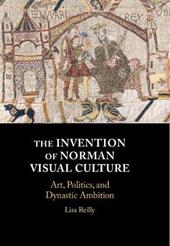
|
The Invention of Norman Visual Culture: Art, Politics, and Dynastic Ambition
Hardback
Main Details
| Title |
The Invention of Norman Visual Culture: Art, Politics, and Dynastic Ambition
|
| Authors and Contributors |
By (author) Lisa Reilly
|
| Physical Properties |
| Format:Hardback | | Pages:224 | | Dimensions(mm): Height 259,Width 183 |
|
| Category/Genre | Byzantine and medieval art c 500 CE to c 1400 |
|---|
| ISBN/Barcode |
9781108488167
|
| Classifications | Dewey:709.40902 |
|---|
| Audience | | Professional & Vocational | |
|---|
| Illustrations |
Worked examples or Exercises; 13 Plates, color; 47 Halftones, black and white
|
|
Publishing Details |
| Publisher |
Cambridge University Press
|
| Imprint |
Cambridge University Press
|
| Publication Date |
20 February 2020 |
| Publication Country |
United Kingdom
|
Description
In this book, Lisa Reilly establishes a new interpretive paradigm for the eleventh and twelfth-century art and architecture of the Norman world in France, England, and Sicily. Traditionally, scholars have considered iconic works like the Cappella Palatina and the Bayeux Embroidery in a geographically piecemeal fashion that prevents us from seeing their full significance. Here, Reilly examines these works individually and within the larger context of a connected Norman world. Just as Rollo founded the Normandy 'of different nationalities', the Normans created a visual culture that relied on an assemblage of forms. To the modern eye, these works are perceived as culturally diverse. As Reilly demonstrates, the multiple sources for Norman visual culture served to expand their meaning. Norman artworks represented the cultural mix of each locale, and the triumph of Norman rule, not just as a military victory but as a legitimate succession, and often as the return of true Christian rule.
Author Biography
Lisa Reilly is Associate Professor in the School of Architecture, University of Virginia. She is the author of An Architectural History of Peterborough Cathedral (1997) and Vassar College (2004), editor of Skyscraper Gothic (2017), and served as the editor of Gesta.
Reviews'It is ambitious in its scope, and an easy, stimulating read.' Caroline Bruzelius, Journal of the Society of Architectural Historians
|